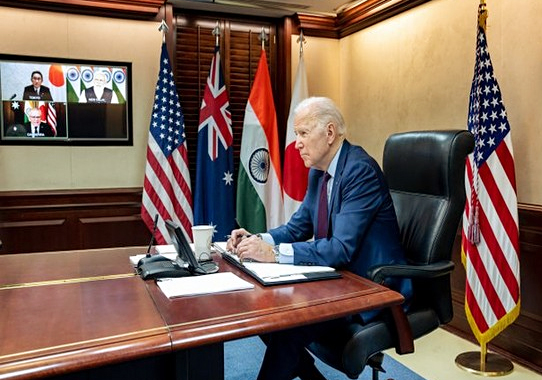A determinant of Biden’s LAM policy has been the Chinese investment in the infrastructure sector.
The focus on Latin America (LAM) has witnessed altered intensity under different Presidencies in the United States. LAM leaders have reconciled to the ebb and flow of American engagement over the years that started with President Franklin D. Roosevelt’s “Good Neighbour” policy towards Latin America. In recent years, the Obama administration had a softer tone towards Latin America and emphasized multilateral cooperation in trade, migration, and environmental issues. His successor Donald Trump had a lukewarm approach and his policies towards Latin America were designed across four fronts: migration, NAFTA (North American Free Trade Agreement), Venezuela and Cuba. The policies of the Trump administration had substantial bearings on the inter-American and South American multilateralism. One embodiment of this approach has been breaking with the norm that the Inter-American Development Bank (IDB) always had a Latin American president. Though President Trump had largely ignored Latin America mainly as part of a broader withdrawal from international affairs, the Latin American leaders, thereafter, have adapted their policies to account for this apathy of U.S. leadership.
The reason why expectations of the LAM region from President Biden are high is that two out of three Latinos voted in the election in favour of him. Moreover, he is the US President with the greatest knowledge of and experience in the area since the end of the Cold War. In his tenure as the Vice President under Obama, he had spent decades working in the region. Therefore, with the assumption of the presidency, it is anticipated that he would make attempts to rebuild America’s upbeat image in the region. Biden’s soft attitude towards Latin America emanates from three elements: as a senator in the 1990s, he was the point person on the Plan Colombia which was an anti-drug-trafficking, anti-violence financial and security package for Colombia; as Obama’s Vice President he with Northern Triangle leaders to draft the guidelines for the Alliance for Prosperity, which offered foreign aid in exchange for domestic reforms and economic investment and the pledge that anti-poverty and security goals were priority areas; and the motivation emanating from his Catholic faith. Biden’s policies towards LAM are circumscribed by specific challenges: immigration from LAC; the Chinese presence in trade and investment; the climate change issues; the situation in and around Venezuela; support for democracy and human rights; and the COVID 19 pandemic.
President Biden endorses that Washington has to care for and support the Northern Triangle nations (El Salvador, Guatemala and Honduras) where directly or indirectly the US has had a role to play in the political and economic turmoil. In tune with this belief, during the initial months of his administration, considerable focus was on immigration, especially from Central America, and to end some of the restrictive immigration policies of the previous administration. His plan ‘Call to Action’ that updates the 2015 Alliance for Prosperity includes earmarking 4 billion US dollars over four years to fund anti-corruption efforts, fight for the eradication of poverty and crime within their borders. Vice president Kamala Harris visited the Northern Triangle countries and Mexico to address the issue of illegal immigrants and her insistence was on plugging the root cause of migration. She has rallied large multilateral firms to invest in the region to generate jobs.
Another determinant of Biden’s LAM policy has been the Chinese investment in the infrastructure sector. He has been careful to talk about Chinese financing because the administration recognises that to vie with the Chinese propositions, competitive and alternative proposals are required. Interestingly, much of the build-back better world (B3W) initiative of the G7 countries is intended to compete with China’s Belt and Road Initiative (BRI) in this Hemisphere.
A new challenge in the form of COVID 19 brought to fore the concerns that a prolonged health crisis in the LAM countries could drive even more people north. The pandemic has dragged 22 million people into poverty, while bankruptcy spread among businesses. Latin America’s gross domestic product contracted in 2020, the worst of any region. To tackle the pandemic, Latin America has received roughly half of all U.S. vaccine donations, about 38 million doses. The United States has an important role in restoring the values critical to pandemic preparedness and response by exercising its competence in the field.
While the pandemic-hit Latin America inches toward recovery, the governments have to align their rebuilding strategies with the commitments under the 2015 Paris climate agreement which would require the assistance of the US. Leaders like Ivan Duque of Colombia, Alberto Fernández of Argentina, and Sebastián Piñera of Chile, who have made ambitious pledges to cut emissions, require investments in renewable energy and energy storage and transmission projects through the Export-Import Bank, Development Finance Corporation, and multilateral development banks. This can be the right sector for US investment and technological assistance.
Biden envisions a hemisphere that would be secure and democratic, from the northern reaches of Canada to the southern tip of Chile. In essence, Biden could use Latin America to send out a signal towards the restoration of Washington’s historic leadership and focus on multilateralism to cement the ties. The next Summit of the Americas (to be hosted by the United States in 2022) could be an opportunity for the US administration to articulate a renewed policy agenda for the region and strengthen engagement with the hemispheric leaders.
Dr Aprajita Kashyap is a faculty at CCUS & LAS, School of International Studies, JNU.

